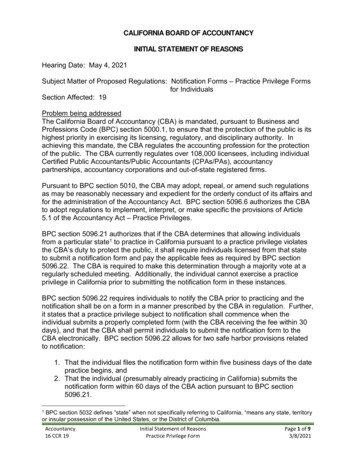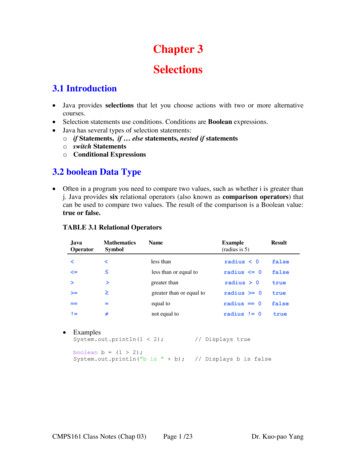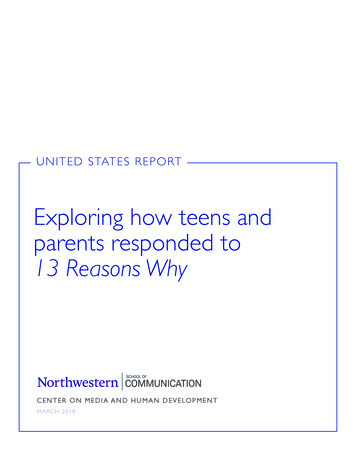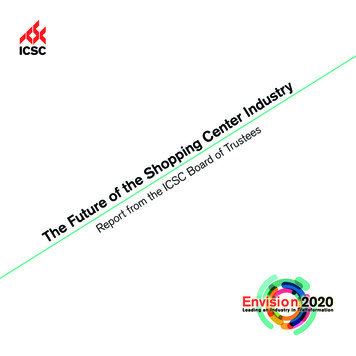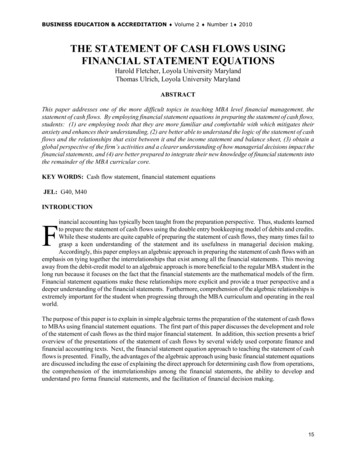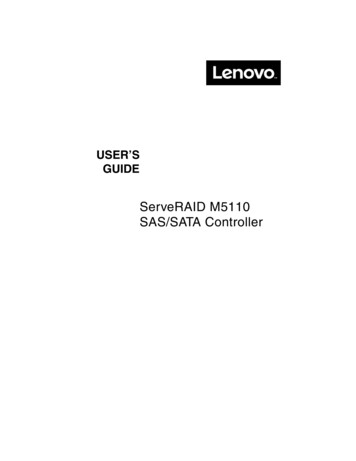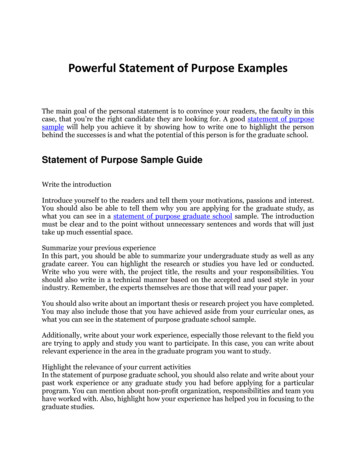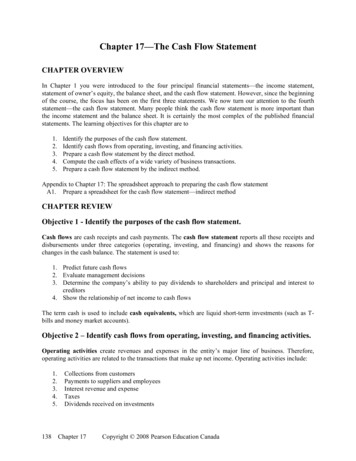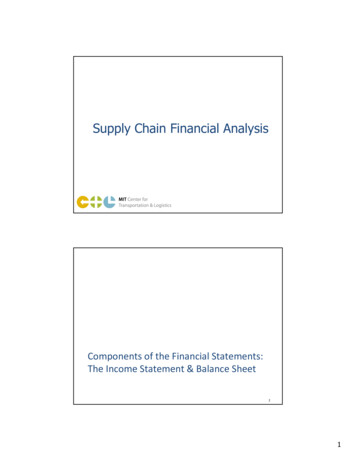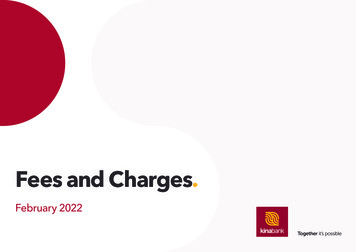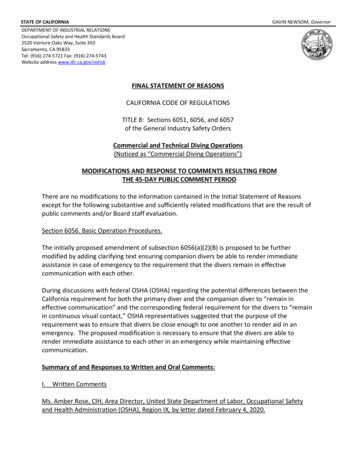
Transcription
STATE OF CALIFORNIAGAVIN NEWSOM, GovernorDEPARTMENT OF INDUSTRIAL RELATIONSOccupational Safety and Health Standards Board2520 Venture Oaks Way, Suite 350Sacramento, CA 95833Tel: (916) 274-5721 Fax: (916) 274-5743Website address www.dir.ca.gov/oshsbFINAL STATEMENT OF REASONSCALIFORNIA CODE OF REGULATIONSTITLE 8: Sections 6051, 6056, and 6057of the General Industry Safety OrdersCommercial and Technical Diving Operations(Noticed as “Commercial Diving Operations”)MODIFICATIONS AND RESPONSE TO COMMENTS RESULTING FROMTHE 45-DAY PUBLIC COMMENT PERIODThere are no modifications to the information contained in the Initial Statement of Reasonsexcept for the following substantive and sufficiently related modifications that are the result ofpublic comments and/or Board staff evaluation.Section 6056. Basic Operation Procedures.The initially proposed amendment of subsection 6056(a)(2)(B) is proposed to be furthermodified by adding clarifying text ensuring companion divers be able to render immediateassistance in case of emergency to the requirement that the divers remain in effectivecommunication with each other.During discussions with federal OSHA (OSHA) regarding the potential differences between theCalifornia requirement for both the primary diver and the companion diver to “remain ineffective communication” and the corresponding federal requirement for the divers to “remainin continuous visual contact,” OSHA representatives suggested that the purpose of therequirement was to ensure that divers be close enough to one another to render aid in anemergency. The proposed modification is necessary to ensure that the divers are able torender immediate assistance to each other in an emergency while maintaining effectivecommunication.Summary of and Responses to Written and Oral Comments:I. Written CommentsMs. Amber Rose, CIH, Area Director, United State Department of Labor, Occupational Safetyand Health Administration (OSHA), Region IX, by letter dated February 4, 2020.
Commercial and Technical Diving OperationsFinal Statement of ReasonsPublic Hearing: February 20, 2020Page 2 of 7Comment:Ms. Rose states that the proposed occupational safety and health standards do not appear tobe commensurate with the federal standard. Specifically:1. OSHA does not recognize “Technical Diving”, only Commercial and Scientific Diving asdefined in 29 CFR Subpart T. The use of the term is not prohibited, but the regulationsmust still be as effective as the federal standard.2. OSHA does not consider the term “effective communication” in Section 6056(a)(2)(B) tobe as effective as the comparable standard 29 CFR 1910.424(c)(2) term “continuousvisual contact”.3. OSHA does not consider Section 6056(a)(2) on hookah diving as effective since it isdefined as surface-supplied air diving and OSHA requires the ability to communicatewith this method.Response:Item 1. The Board appreciates the comment. With regard to the assertion that the proposeddefinition and requirements for technical diving are not at least as protective as federalregulations, the Board points Federal OSHA to the following facts:The proposed definition for technical diving in Article 152 is intended to fill a void that exists infederal regulations between traditional construction commercial diving and scientific diving.The proposed definition more accurately reflects occupational diving in specializedenvironments and therefore more adequately protects divers engaged in the practice. Federalstandards, written more than 40 years ago, are designed to protect employees engaged inunderwater drilling and construction, whose activities include such tasks as placing or removingheavy objects, pipeline inspection, construction, demolition, cutting or welding, or the use ofexplosives.By definition, technical divers perform tasks which are not part of an on-going construction,demolition, repair, maintenance, shipbuilding, shipbreaking, or ship repair job. Instead, theiractivities involve making or performing observations, measurements, and adjustments, film andTV diving, and zoo and aquarium exhibit diving.In support of this distinction, the Fifth Circuit Court of Appeals published a July 15, 2020,decision, reversing a ruling by the Occupational Safety and Health Review Commission, wherethe Commission ruled that cleaning and feeding dives at the Houston Aquarium were subject to
Commercial and Technical Diving OperationsFinal Statement of ReasonsPublic Hearing: February 20, 2020Page 3 of 7the requirements of the federal Commercial Diving Operations (CDO) regulations 1. The decisionincludes the following finding:The regulatory history [of the CDO regulation] as a whole highlights that OSHA’spurpose in creating the CDO standard was to improve workplace safety for diversworking on dangerous tasks such as construction and drilling, which are not present atthe Aquarium. OSHA discerned that institutions like the Aquarium, which can achieve alow rate of, or no accidents by self-regulation, did not require regulation under the CDOstandard. (Page 12.)Further, the decision states that “there is evidence that adding the additional safetyequipment required under the CDO standard could make the divers and animals less safe inthe Aquarium environment.” (Page 13, emphasis added.) Although the decision focuses on thedifferences between scientific and commercial diving operations, technical diving operationsare also “clearly distinguishable from any of the listed activities, which are typically associatedwith construction and industrial work.” (Page 11.)The Board asserts that the hazards of a diving operation are based upon the nature, depth, andenvironment of the task being performed, as well as the training of the person performing thetask. The existence of an alternate set of requirements for scientific divers is proof thatdifferent tasks are treated differently by the CDO regulations. Because scientific divers do notperform tasks with the same degree of risk as commercial divers, they are allowed to selfregulate. The tasks performed, not the job classification, determine the hazards and thenecessary precautions to be taken.By the same reasoning, technical divers perform tasks more closely related to scientific diversand are clearly distinguishable from commercial divers. However, instead of seeking to selfregulate, as many of them could qualify to do as scientists, they are requesting a uniform set ofregulations tailored to their specialized, non-construction dive environments. Stakeholdertestimony includes decades of dive experience and thousands of hours of underwater practiceattesting to the equivalent safety of technical diving when compared to commercial diving.Item 2. In discussions with representatives from federal OSHA on the merits of “effectivecommunication” vs. “continuous visual contact,” both sides cited instances where one termcould prove more protective than the other. The discussion resulted in the intent of therequirement being that the companion SCUBA diver required by subsection 6056(a)(2)(B) “beable to render immediate assistance in case of an emergency” to the other diver. As a result ofthe comment and follow-up discussions, the Board proposes to explicitly require the intent ofthe federal and state regulations, instead of using the vague term “continuous visual contact.”United States Court of Appeals, Fifth Circuit. “Houston Aquarium, Inc. v. Occupational Safety and Health ReviewCommission; Eugene Scalia, Secretary, U.S. Department of Labor.” No. 19-60245. Document: 00515490818. FiledJuly 15, 2020, 45-CV0.pdf.1
Commercial and Technical Diving OperationsFinal Statement of ReasonsPublic Hearing: February 20, 2020Page 4 of 7Item 3. Hookah diving is a necessary diving mode for technical divers and has been performedsafely in California since 1980, according to stakeholder testimony. Stakeholders diving in thespecialized environments of zoo and aquarium exhibits assert that the small footprint andminimal equipment requirements of hookah diving are the most safe and effective mode forthe small, delicate, specialized environments where animals, corals and humans are in suchclose proximity. Although some exhibits could fit the additional equipment required by the CDOregulation and the requirements for SCUBA or surface-supplied air diving, in many instances theequipment will not fit safely into the tank or work area and can pose an obstacle in rescuing adiver in the event of an emergency. Similarly, film and TV divers use hookah for cameraoperators filming in small spaces like swimming pools, where excess equipment can impedecamera movement.In support of hookah diving and the reduction of unnecessary diving equipment in specializeddiving environments, the Fifth Circuit Court decision states:Indeed, the alleged violations with which the Aquarium has been charged were notshown in the record to have safety benefits. OSHA charged the Aquarium with, interalia, not having a two-way communication system, not having a reserve air supply, andnot having a safety harness. The Aquarium’s Senior Dive Officer, Todd Hall, testified thatAquarium divers do not need a two-way communication system, because unlike diverswho may be in open or murky water or separated by long distances, Aquarium diverscan easily see the spotter standing outside of the tank and can communicate using handsignals. Divers also do not need reserve air supplies in the Aquarium’s tanks that are amere 12 or 14 feet deep. If a diver loses his air supply, he can propel himself to thesurface in equal or less time than switching to a second air supply. Lastly, divers do notneed safety harnesses, which are used for emergency extractions, because theAquarium uses quick-deploy harnesses when needed. Because of the short distance,divers can be pulled out using these harnesses in less than two minutes. . Indeed,there is evidence that adding the additional safety equipment required under the CDOstandard could make the divers and animals less safe in the Aquariumenvironment.(Pages 12 and 13.)The Board is not persuaded by the comment and asserts that the lack of a two-way voicecommunication system does not affect the overall safety of the dive mode. Although the FifthCircuit Court decision mentions that a reserve air supply and safety harness “were not shown inthe record to have safety benefits” (page 12), California technical divers seek to explicitlyrequire these and other safety measures to ensure adequate employee protections whileengaged in hookah diving. The Board asserts that the proposed regulations for technical divers,which are specifically tailored to the specialized environments in which they work, are at leastas protective as the CDO regulations when implemented as proposed.
Commercial and Technical Diving OperationsFinal Statement of ReasonsPublic Hearing: February 20, 2020Page 5 of 7The Board thanks Ms. Rose for her comment and participation in the Board’s rulemakingprocess.Mr. Andrew Solomon, Dive Safety Officer / Boating Safety Officer, California Science CenterFoundation, by letter dated February 10, 2020.Mr. Paul Dimeo, Dive Safety Officer, Aquarium of the Pacific, by letter dated February 12, 2020.Mr. George Z. Peterson, Director of Dive Programs / Diving Control Board Chairman, MontereyBay Aquarium, by letter dated February 12, 2020.Comment:The commenters were in support of the proposed amendments and urged the Board to adoptthe proposed modifications to the regulation.Response:The Board thanks the commenters for their comments and participation in the Board’srulemaking process.II. Oral CommentsOral comments received at the February 20, 2020, Public Hearing in Rancho Cordova, California.Mr. Andrew Solomon, Dive Safety Officer / Boating Safety Officer, representing the CaliforniaScience Center Foundation.Mr. Paul Dimeo, Dive Safety Officer, representing the Aquarium of the Pacific.Mr. George Z. Peterson, Director of Dive Programs / Diving Control Board Chairman,representing the Monterey Bay Aquarium.Comment:The commenters echoed their written comments in support of the proposed amendments andurged the Board to adopt the proposed modifications to the regulation.Response:The Board thanks the commenters for their comments and participation in the Board’srulemaking process.
Commercial and Technical Diving OperationsFinal Statement of ReasonsPublic Hearing: February 20, 2020Page 6 of 7MODIFICATIONS AND RESPONSE TO COMMENTS RESULTING FROMTHE 15-DAY NOTICE OF PROPOSED MODIFICATIONSNo further modifications to the information contained in the Initial Statement of Reasons areproposed as a result of the 15-day Notice of Proposed Modifications mailed on October 2,2020.Summary of and Responses to Written and Oral Comments:Ms. Amber Rose, CIH, Area Director, United State Department of Labor, Occupational Safetyand Health Administration (OSHA), Region IX, by letter dated October 14, 2020.Comment:Ms. Rose reiterated her concerns from her February 4, 2020, letter written in response to theinitial 45-day comment period, except for the change proposed in the 15-day notice. Regardingthe proposed change in the 15-day notice, she wrote in support of the amendment, saying thatfederal OSHA finds the language ALAEA (at least as effective as the federal requirements).Response:The Board thanks Ms. Rose for her comments and participation in the Board’s rulemakingprocess. For the Board response to Ms. Rose’s 45-day comment period concerns, please see theBoard’s response to her February 4, 2020, letter above.Mr. Andrew Solomon, Dive Safety Officer / Boating Safety Officer, California Science CenterFoundation, by letter dated October 22, 2020.Mr. Paul Dimeo, Dive Safety Officer, Aquarium of the Pacific, by letter dated October 20, 2020.Mr. George Z. Peterson, Director of Dive Programs / Diving Control Board Chairman, MontereyBay Aquarium, by letter received October 23, 2020.Comment:The commenters were in support of the proposed amendments and urged the Board to adoptthe proposed modifications to the regulation.
Commercial and Technical Diving OperationsFinal Statement of ReasonsPublic Hearing: February 20, 2020Page 7 of 7Response:The Board thanks the commenters for their comments and participation in the Board’srulemaking process.ADDITIONAL DOCUMENTS RELIED UPONUnited States Court of Appeals, Fifth Circuit. Houston Aquarium, Inc. v. Occupational Safetyand Health Review Commission; Eugene Scalia, Secretary, U.S. Department of Labor. No. 1960245. Document: 00515490818. Filed July 15, -60245-CV0.pdf.This document is available for public inspection BY APPOINTMENT Monday through Fridayfrom 8:00 a.m. to 4:30 p.m. at the Standards Board office located at 2520 Venture Oaks Drive,Suite 350, Sacramento, California. Appointments can be scheduled via email atoshsb@dir.ca.gov or by calling (916) 274-5721.ADDITIONAL DOCUMENTS INCORPORATED BY REFERENCENone.DETERMINATION OF MANDATEThese standards do not impose a mandate on local agencies or school districts.ALTERNATIVES CONSIDEREDThe Board invited interested persons to present statements or arguments with respect toalternatives to the proposed standard. No alternative considered by the Board would be: (1)more effective in carrying out the purpose for which the action is proposed, or (2) would be aseffective as and less burdensome to affected private persons than the adopted action, or (3)would be more cost-effective to affected private persons and equally effective in implementingthe statutory policy or other provision of law. Board staff were unable to come up with anyalternatives or no alternatives were proposed by the public that would have the same desiredregulatory effect.
underwater drilling and construction, whose activities include such tasks as placing or removing heavy objects, pipeline inspection, construction, demolition, cutting or welding, or the use of explosives. By definition, technical divers perform tasks which are not part of an on-going construction, demolition, repair, maintenance, shipbuilding .
